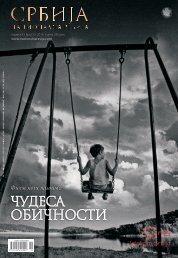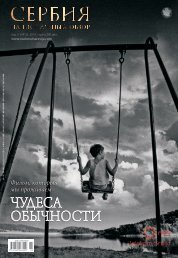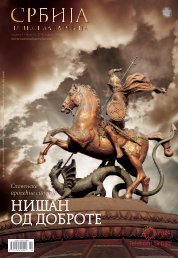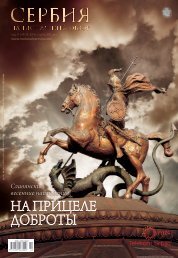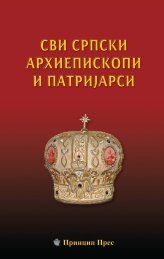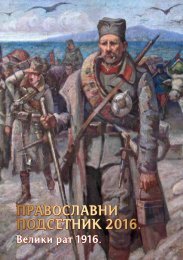Monografija - prvo izdanje - niska rezolucija
You also want an ePaper? Increase the reach of your titles
YUMPU automatically turns print PDFs into web optimized ePapers that Google loves.
са ве зни ци ма, сво јим угар ским има њи ма и пе штан ским па ла тама.<br />
Та ко је Ср би ја из ви зан тиј ског кул тур ног кру га, сту пи ла<br />
на праг Евро пе.<br />
Бе о град ће се Тур ци ма од у пи ра ти ду же од Ср би је. Aли,<br />
„fa tum tru hend”.<br />
Сме де ре во, пре сто ни ца Сте фа но вог на след ни ка, де спота<br />
Ђур ђа, јед на од нај ве ћих твр ђа ва Евро пе, сво јом пре да јом<br />
(1459) озна чи ло је крај срп ског сред њо ве ков ног го спод ства и<br />
пад Ср би је под Тур ке. Два де се ти пет ви со ких дон жо на, ко ји су<br />
бра ни ли твр ђа ву по вр ши не од пре ко де сет хек та ра (из гра ђе ну<br />
за ма ње од де сет го ди на) и да нас огле да сво је моћ не зи до ве<br />
у во да ма Ду на ва, све до че ћи, опет и опет, да не ма твр ђа ве до<br />
људ ског ду ха, а да се од стра ха и без на ђа ни нај де бљим зи до вима<br />
чо век не мо же од бра ни ти – бра ни о ци су град, зи дан да бу де<br />
нео сво јив, пре да ли Тур ци ма, ослу шку ју ћи мрач ни и пре те ћи<br />
хук ислам ског мо ра ко је их је за пљу сну ло, уви дев ши да им нико<br />
с оне стра не Ду на ва, где је по чи њао свет хри шћан ства, та да<br />
као и по че шће у исто ри ји крат ко ви до за у зет сво јим ме ђу со би цама<br />
и бор ба ма око ра зних пре сто ља, не ће при те ћи у по моћ.<br />
Hic tran sit glo ria mun di!<br />
Тек 1521. Су леј ман Ве ли чан стве ни за у зе ће Бе о град,<br />
ис пу ња ва ју ћи за вет сул та на Му ра та Дру гог (чи ју су вој ску од<br />
100.000 рат ни ка хра бри бра ни о ци под за по вед ни штвом Кор чу<br />
„У<br />
(in 1453 the walls of Constantinople, “the capital of the world” fell<br />
down). Serbs, who for a long time had their back turned toward<br />
Danube, were again forced to turn their faces toward the great<br />
waterway of Europe, as they had to flee from invading Ottomans.<br />
Despot Stefan Lazarević, dubbed The Tall, a knight of the<br />
Dragon’s order, warrior, diplomat and poet, moved the capital of<br />
Serbia from Kruševac, a town from where his father the “honorable<br />
Prince” Lazar went to the greatest battle in Serbian history,<br />
to the field of Kosovo (1389). This was done in order to ascend<br />
from the earth to a heavenly kingdom, to pass away, perish and<br />
seek revenge by the killing of Sultan Murat. Wishing to be closer<br />
to his Christian allies, his properties in Hungary and palaces in<br />
Pest, the Despot ruled from Belgrade, a fortified city built on the<br />
place where the Danube marries the Sava, at one of the prettiest<br />
points on the Danube – in the city that had been governed by<br />
Scordisci, Goths, Romans, Byzantines, Bulgarians, and Hungarians<br />
before him. In that way Serbia, being part of the Byzantine<br />
cultural circle in the past, entered the doorway of Europe.<br />
Belgrade resisted the Turks much longer than Serbia. But,<br />
fatum truhend. With the surrender of Smederevo, the capital chosen<br />
by Stefan’s heir, Despot Đurađ and a city with one of the largest<br />
fortresses in Europe, the end of Serbian medieval governing<br />
came about as well as the ultimate fall of Serbia to the Turks.<br />
зби ва њи ма ис пу ње не ним не ми ри ма, се о ба ма и бо је ви ма, Ду нав је на раз не на чи не ула зио у европ ску повјест.<br />
Су ви ше спо ро је до зре ва ла ми сао да кр ва ве стра ни це про шло сти ко ја се зби ва ла на Ду на ву и уло гу<br />
да слу жи као гра ни ца на ро ди ма, тре ба за ме ни ти сми слом ре ке ко ја спа ја. Та ми сао из ре че на је у Ве ћу Евро пе<br />
1956, ка да је са ста вље на ње на Про грам ска кар та во да, и об ја вље но на че ло – во да не по зна је др жав не гра ни це.<br />
Она зах те ва ме ђу на род ну са рад њу, за јед нич ки на пор да се са чу ва њен угро же ни жи вот. За ис пу ње ње ова ко из раже<br />
ног на че ла, не ма ва жни јег за дат ка за ује ди ње ну Евро пу, од оног ко ји је оба ве зу је на за јед нич ку бри гу о ње ној<br />
нај ва жни јој ре ци. Ни је спор но да Ду нав при па да Евро пи, не го да ли Евро па при па да Ду на ву!“<br />
(Из по го во ра књи зи о Ду на ву ака де ми ка Де ја на Ме да ко ви ћа)<br />
n events filled with calamities, migrations and battles, the Danube was entering in diverse ways into the history<br />
“Iof Europe. A belief that the bloody pages of the past taking place on the Danube and the Danube’s role as a border<br />
between nations developed slowly into the opinion that the Danube should be known as a river that connects. That<br />
thought was proclaimed at the Council of Europe in 1956, when its Program Map of Waters was created, and a principle<br />
that water doesn’t recognize borders was also declared. Water demands international cooperation and joined efforts<br />
in order to protect its jeopardized existence. To fulfill the principle expressed in this way, united Europe doesn’t have a<br />
more important task than one that requires joined concern of its most important river. The fact that the Danube belongs<br />
to Europe is not disputable, but it is disputable if Europe belongs to the Danube.<br />
46<br />
(From the epilogue of the book about the Danube by academic Dejan Medaković)



